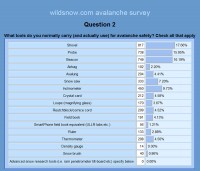Thanks to everyone who took the avalanche survey I posted a while ago. More than 770 of you responded! I’m no statistician, and I learned a ton from making this survey (it was a college project). Some of the questions could have been worded better, but I didn’t change them after people began filling it out, so as to not skew the results.
The survey confirmed a lot of the things I’ve always assumed about the backcountry skiing community, and also gave unique insights I used for a prototype idea that involved taking the first step in “research driven design.” Click on the thumbnails to view the results, apologies in advance if our image enlarger doesn’t work for you (it works for nearly every browser/computer combination, but sometimes folks have problems with it.) We had to keep the results as jpeg screen shots since converting them to HTML tables that fit our blog design would have been a monumental task.
Question one: How would you describe your experience level? (Multiple answers can be selected, i.e. if you are a guide with level 3 AIARE). Rate either based on experience, course level, or both (i.e. if you have many years of experience, but no formal courses, you could choose expert)
This question is the main one that could have been worded much better. The results might have been skewed toward the third option because many backcountry skiers have little to no “official” avy education, even if they have a wealth of experience.
Question two: What tools do you normally carry (and actually use) for avalanche safety? Check all that apply.
Question three: How often do you do the following for pre-trip planning?
Question four: What avalanche mitigation/evaluation techniques do you use? How often?
Question five: How often do you ski one at a time?
Question six: During a day in avalanche terrain, what information is the most important to you? Drag and drop to rate according to importance.
The results for this question are hard to interpret. Also, the results might have been skewed since the method for answering this question was hard to understand. As far as I can tell, the simplified results are below, rated from most to least important, I could be interpreting it completely wrong, and the results might not actually mean anything. Question 7 perhaps does a better job of gathering this sort of information.
1. Slope angle
2. Nearby avalanche activity
3. Wind direction speed/history
4. Snow accumulation history
5. Snowpack layer bonding
6. Solar radiation history
7. Snowpack layer hardness
8. Snowpack layer density
9. Snowpack layer thickness
10. Snowpack layer temperature
11. Snow depth
12. Partners risk acceptance level
13. Slope history
Question seven: If you could have better quality (i.e. quicker, more accurate, more often) of any kind of avalanche safety related data, what would it be?
In summary:
It was encouraging to see how many people still skied one-at-a-time, despite the seeming trend (gleaned from observing accidents worldwide) against this most basic principle of safety.
You might also notice that of the many techniques used to evaluate hazard, that of examining snow layers is ever popular in backcountry skiing. But methods of observing snow layers are either primitive (ski pole probe), or time consuming (pit profiles). While all areas of avalanche safety are open for improvement, in my view the survey shows that new gear or techniques for evaluating snow layering could be of top importance.
As we’ve previously written about here on WildSnow.com, perhaps the days of avalanche beacons being viewed as the ultimate mojo of avalanche survival are behind us, and new safety devices are on the horizon? The growing popularity of airbag backpacks testifies, but how about gear that helps keep you out of avalanches in the first place?
Louie Dawson earned his Bachelor Degree in Industrial Design from Western Washington University in 2014. When he’s not skiing Mount Baker or somewhere equally as snowy, he’s thinking about new products to make ski mountaineering more fun and safe.







